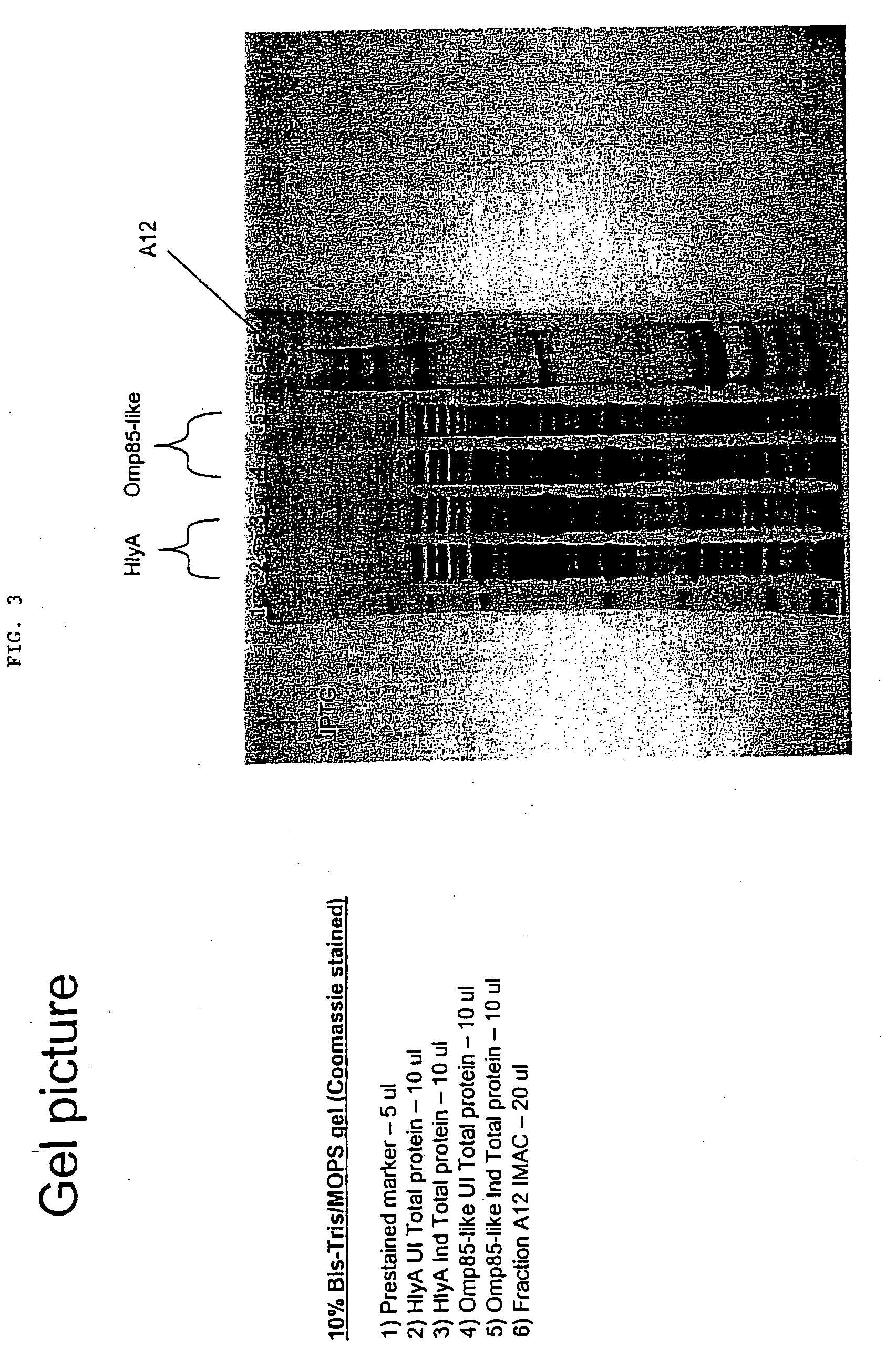Lawsonia intracellularis immunological proteins
an antigen and intracellular technology, applied in the field of lawsonia intracellularis antigens, can solve the problems of increased fcr, reduced appetite, delayed growth, etc., and achieve the effect of enhancing resistance to new infections and reducing clinical severity of diseases
- Summary
- Abstract
- Description
- Claims
- Application Information
AI Technical Summary
Benefits of technology
Problems solved by technology
Method used
Image
Examples
example 1
[0132]This example demonstrates the immunological detection of the Lawsonia intracellularis DK15540 hemolysin A (HlyA) and Omp85 proteins expressed as prokaryotic fusion proteins.
[0133]Materials and Methods
[0134]Transforming E. coli Strains
[0135]To begin, McCoy cell DNA was removed from a Lawsonia intracellularis (“Lawsonia”) cell pellet. This was done by first propagating the DK15540 strain of Lawsonia in a McCoy cell suspension culture. The Lawsonia infected McCoy cells were then pelleted by centrifugation at 10,000 rpm for 30 minutes at 4° C. using a JA-17 rotor (Beckman Coulter, Fullerton, Calif.). The supernatant was removed and the pelleted cells were then disrupted by repeated passage through a 22G double-hub emulsifying needle using two syringes. The disrupted cell mixture was then mixed with 35 mL of a Percoll / NaCl solution. The resulting solution was then centrifuged at 14,000 rpm for 45 minutes at 4° C. After centrifugation, the upper layer of debris was removed with a pi...
example 2
[0147]This example demonstrates the purification of hemolysin A and Omp85-like Lawsonia proteins expressed in E. coli cells.
[0148]Materials and Methods
[0149]10 mL of each of the transformed strains of E. coli were grown overnight in a media of LB, 2% glucose, and 50 μg / mL of Ampicillin. The next morning, the overnight cultures were used to inoculate a IL pre-warmed broth of LB, glucose, and Ampicillin. These cultures were grown at 37° C. for about 3-4 hours until they had reached an OD600 nm of about 0.8 to about 1.0. The cultures were then each induced for 3.5 hours at 37° C. with 0.5 mM IPTG. After induction, the cells were then collected and pelleted by centrifugation at 20,000×g for 20 minutes. The pellet was then suspended in a 33 mL buffer containing 50 mM sodium phosphate, 0.5M sodium chloride, 8M urea, 5 mM 2-ME, and 10 mM imidazole. The resulting suspension was then extracted overnight to disrupt the cells and denature the protein and thereby increase the solubility at 4° C...
example 3
[0152]This example demonstrates the immunological detection of the Omp85-like and Hemolysin A total proteins.
[0153]Materials and Methods
[0154]The Omp85-like protein, HlyA protein, and IMAC fraction A12 protein were used in three Western blots. The first blot was completed with a Lawsonia ELISA antibody, which was obtained from convalescent pig sera harvested from a 9 week old pig which had previously tested negative for Lawsonia infection by IFAT and ELISA (a “strict control”). The antibody had been diluted to 1:50 in TTBS+2% dry milk. The second blot was completed with swine anti-Lawsonia convalescent serum which had been diluted 1:50 in TTBS+2% dry milk. The third blot was a conjugate-only blot completed using a goat anti-swine HRP which had been diluted 1:1000 in TTBS+2% dry milk (KPL, Inc., Gaithersburg, Md.).
[0155]First, the proteins were run through an SDS-PAGE gel (10% Bis / Tris in a MOPS buffer). The proteins were then transferred from the gels to a PVDF membrane at a constan...
PUM
| Property | Measurement | Unit |
|---|---|---|
| immunological composition | aaaaa | aaaaa |
| nucleic acid | aaaaa | aaaaa |
| length | aaaaa | aaaaa |
Abstract
Description
Claims
Application Information
 Login to View More
Login to View More - R&D
- Intellectual Property
- Life Sciences
- Materials
- Tech Scout
- Unparalleled Data Quality
- Higher Quality Content
- 60% Fewer Hallucinations
Browse by: Latest US Patents, China's latest patents, Technical Efficacy Thesaurus, Application Domain, Technology Topic, Popular Technical Reports.
© 2025 PatSnap. All rights reserved.Legal|Privacy policy|Modern Slavery Act Transparency Statement|Sitemap|About US| Contact US: help@patsnap.com



